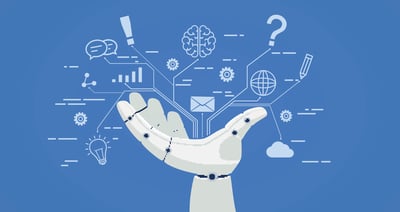July 26, 2024
.png?width=400&height=150&name=G2_Logo_Red_RGB%20(1).png) by G2 / July 26, 2024
by G2 / July 26, 2024

An email marketing is a vital component of B2B marketing strategy. With buyers doing so much research on their own, there's never been a better time to nurture those relationships via email.
These 10 tips will help you get the most from every campaign you create:
Most B2B buying decisions are made by committees, not individuals. These committees consist of a variety of professionals with different skill sets and interests. Trying to appeal to all key stakeholders in the same email is impossible.
The solution? Create buyer personas for each key stakeholder, then segment your email list accordingly. This allows you to create unique email campaigns that target specific personas. EZMarketing has a great resource for buyer persona templates I would recommend checking out.
It takes some time to set up multiple campaigns. But the effort pays off. By knowing exactly whom you're writing to, it's easier to strike the perfect tone and focus on topics you know will interest them. This helps make your readers feel like you understand them on a deeper level than your competitors.
Like every other marketing effort, email performance should be tracked carefully with an effective email tracking tool. You can't improve what you aren't measuring.
You might have a gut-level feeling for how well your email campaigns are paying off. However, instead of relying on intuition, let's take a data-driven approach.
The challenge for many B2B marketers is too much data. We get overwhelmed before we even start. Fortunately, you can simplify the process.
Start by selecting a few key performance indicators (KPIs). KPIs are the most important data points you'll track to measure success. Some of the most common choices are clickthrough rates, open rates, bounce rates, email deliverability rates, and list growth.
Once you've chosen a handful of KPIs, tracking them with a good email management tool will give you a baseline to improve on. You can experiment with different subject lines, campaigns, frequency, and other variables to see how they affect performance. Continue to measure, and you'll continue to improve!
It makes sense that buyers are using online resources to take research into their own hands. The average B2B purchase is expensive, with complicated products or services over long sales cycles.
It's B2B marketing's role to educate potential buyers about their problem, raise awareness of solutions, and give them the tools they need to make the best decision. This gradual process is suited perfectly for email.
But only in the right tone. If you come across as pushy or “salesly,” you'll irritate your subscribers. If you're informative, approachable, and helpful, you can nurture relationships that end in sales.
Once email subscribers have shown they're ready to take the relationship further (opening certain emails, downloading content, etc.), hand them off to your sales team for a buying conversation.
It can take months – or even years – before a B2B prospect becomes a customer.
Along the way, the buyers' journey breaks down into several stages: awareness, consideration, interest, preference, and purchase. Marketers conceptualize these stages differently, so the terms vary.
Successful email campaigns have the right message at the right time throughout the journey, no matter which stage the buyer is in. They don't email someone who just joins their list via a case study, for instance, because those discuss specific solutions. Your new subscriber might not even know a problem exists!
The idea is to have something for everyone. As buyers progress, your emails will get more in-depth, specific, and solution-oriented.
Emailing is an intimate way to communicate. Usually we're exchanging messages with one other person from the privacy of our own inboxes.
Business emailing uses email marketing software to automate the process. However, the more you can do to make subscribers look past that – to recreate a one-one-one feel – the more your messages will resonate.
It isn't too difficult to do this. Some B2B email marketers address their subscribers by name (pulling the info from their email software product). You could also tailor your “from” address to someone on your team whom the recipients will relate with – HR subscribers could get a message from someone on your HR team, for example. Don't get too cute with this stuff if you're emailing marketers. They're aware of these tactics; overdoing them might backfire.
Most of us are overwhelmed with more emails than we know what to do with. The average worker gets 122 emails a day. If you're targeting busy B2B buyers, this number could increase dramatically.
Subscribers are a lot more motivated to hit the “delete” button (or unsubscribe) than take time out of their day to read your email.
It's up to marketers to sweeten the deal. Instead of relying on witty banner alone – which usually isn't enough to get a consistent response – add valuable content to make your emails more compelling.
Remember, your potential buyers are desperate for information they can trust. By educating them with valuable content, you'll increase the likelihood of them engaging.
What makes content valuable? At a minimum, it's relevant and informative. Bonus points if it's entertaining. Popular B2B content includes: blog posts, guides, eBooks, reports, white papers, and case studies. Tailor which ones you email depending on the subscriber's position in the buying journey.
Sending the same emails over and over again is a sure way to lose subscribers' interest. Unfortunately, that's exactly what some B2B marketers are doing. In their rush to promote time-sensitive events, they'll send their lists repeats.
If you're sharing something time sensitive (webinar, holiday sale, etc.), it only makes sense that you'll want to remind your subscribers repeatedly. That's perfectly fine – as long as you vary your subject lines and content. If you can, find a way to provide a little value while letting them know about your limited-time event.
Your email content is critical, but so is your presentation. When we're scrolling through our packed inboxes, we certainly judge a book by its cover.
Nailing your subject line is crucial. This is like the headline to your email – the first thing subscribers see when deciding whether to open it. Writing great subject lines is an art in and of itself. The general principles are straightforward: If you can intrigue, promise value, and entertain, people are more likely to open your emails.
You don't have to rely on instinct either. With email marketing software, you can A/B test competing subject lines, see which one gets opened more, and continuously improve.
Also consider the format of the email itself. Some people like to design fancy HTML emails based on templates, adding logos, visual elements, and more. Others stick to plain text. Let your intended audience be the guide. Designers might appreciate great design, where a busy executive just wants the information as quickly as possible. In either case, including a link for readers to share the email will increase your reach.
Many B2B email marketers segment their lists by buyer persona, but they stop there. There are so many other ways to slice things up!
It might sound like a hassle to segment subscribers multiple times, but every time you do, you're narrowing your focus. You can approach smaller groups of people in a much more targeted way – skyrocketing your return on investment if done correctly.
Brainstorm a few ways you could segment your list: personas, niche, industry, engagement with your emails, which pieces of content they've downloaded, etc. Using optimized email signup forms can further aid in this segmentation by gathering detailed user data. Marketing automation software can help. Once you set up the rules, the system runs all on its own.
Successful email marketing is like building relationships in real life. You wouldn't call people 10 times a day: they would think you're needy. On the other hand, you wouldn't let six months pass between every time you talk.
You want to communicate as often enough to keep your brand top of mind – without overwhelming or annoying subscribers with too much info.
How often is just right? It depends on your intended audience. Standard practice is to email every few days. You might be able to get away with once a week. Whatever your frequency, keep it consistent so your messages becomes a regular part of your subscribers' routines.
Also experiment with the time of the day you're sending your emails. A message on Monday morning, when things are hectic, is probably a lot less likely to get read than one on a Thursday evening.
The only way you can know for sure is to test. Set frequency and email delivery times, then watch your KPIs closely. Experiment, see the effect, and see what works best.
Email marketing is a complex game. There are more than these ten tips to consider when sending your emails. Another great resource is this guide from Kinsta on the best practices for sending emails.
Email marketing has a lot of moving pieces, but it doesn't need to be overwhelming anymore. Keep these 10 tips in mind, and you'll grow your business while delighting your B2B audience.
Solutions often meet us at intersections.
 by Nanditha Vijayaraghavan
by Nanditha Vijayaraghavan
You can distinguish between B2B vs. B2C marketing, but in the end, you must market for H2H:...
 by Axel Kuehnle
by Axel Kuehnle
Capturing and commanding customer attention when they’re constantly overloaded with content is...
 by Kamaljeet Kalsi
by Kamaljeet Kalsi
Solutions often meet us at intersections.
 by Nanditha Vijayaraghavan
by Nanditha Vijayaraghavan
You can distinguish between B2B vs. B2C marketing, but in the end, you must market for H2H:...
 by Axel Kuehnle
by Axel Kuehnle


